| Mullerornis Temporal range: | |
|---|---|
 | |
| Life restoration | |
| Scientific classification | |
| Kingdom: | Animalia |
| Phylum: | Chordata |
| Class: | Aves |
| Infraclass: | Palaeognathae |
| Order: | † Aepyornithiformes |
| Genus: | † Mullerornis Milne-Edwards & Grandidier 1894 |
| Type species | |
| Mullerornis betsilei Milne-Edwards & Grandidier 1894 | |
| Species | |
| |
 | |
| Map of Madagascar showing where specimens have been found | |
| Synonyms | |
| |
Mullerornis modestus is an extinct species of elephant bird, and the only member of the genus Mullerornis.




